We now come to that time of the month where we talk about things other than avians, and lucky us, I have a few such topics available from the buttload of pics that I got while on vacation in South Carolina. Let’s dive in, shall we?
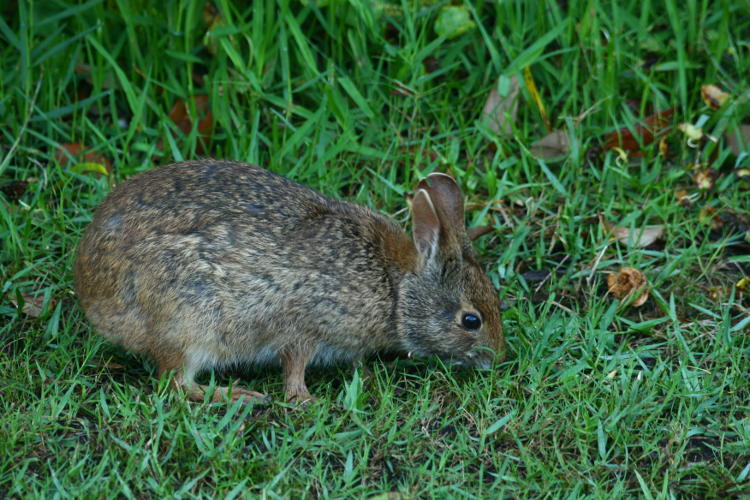
On multiple occasions, during the hike back from the beach after doing my sunrise thing, I encountered a mellow little marsh rabbit (Sylvilagus palustris) that seemed completely unconcerned with my presence. I’d credit this to my remarkable stalking prowess, but seriously, it was so used to activity at the resort that it considered people just background noise. Marsh rabbits are closely related to the extremely common eastern cottontail, but have shorter ears and legs, and of course inhabit the coastal plains and wetlands. I’ve seen them a couple of times before at the Outer Banks of North Carolina, and gotten a few pics, but none as close as I got this trip.
The camera was still set for full sunlight balance after the beach pics, and it captured the open shade twilight (the sun still being behind trees in this area,) rather bluish. So as an illustration, I include a version of the same pic, tweaked more towards a balance as if the light was white, because the difference is notable, and I think that any aspiring nature photographer should be able to spot when the color register is off automatically.
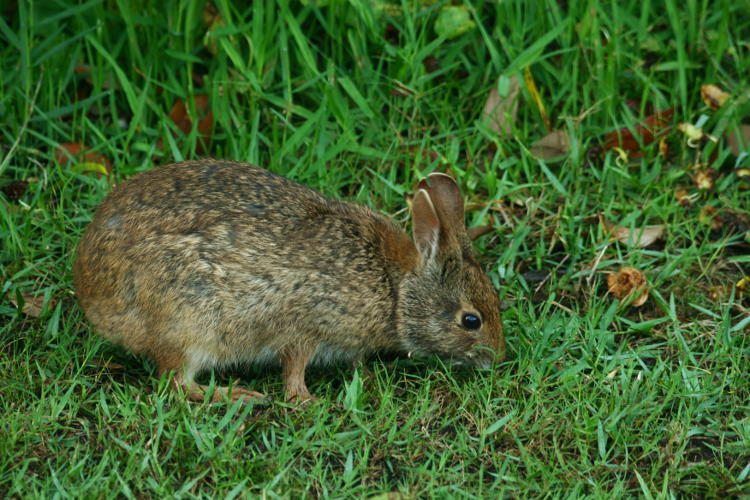
By the way, when I say it was mellow, I’m not exaggerating. One of the mornings, it was being stalked by a feral cat that lived nearby, and was only slightly more alert.

That’s the cat at right, the rabbit being that blob to the left near the post – in this light, there was no way to get a higher depth of field without significant camera shake. You might think this is a dangerous habit for the rabbit to have, but it massed as much as the cat and nonetheless seemed aware. The cat would draw a little closer, centimeters at a time, but before it got within easy pursuit distance, the rabbit would causally hop another couple of meters away. The cat was so intent on this pointless endeavor, however, that after observing it for a few minutes, I was able to continue on my way past it and do some shots from the front. Is this expressive or what?
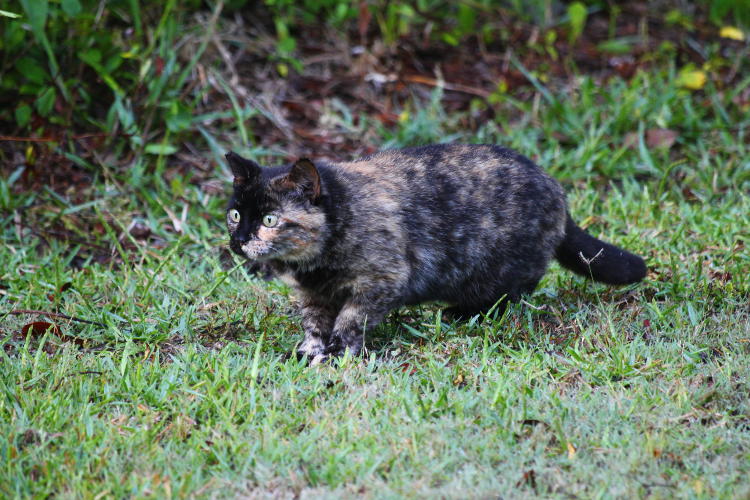
By the way, I said the beach was the most boring I’d been at, but I still made the effort to do something with it. For instance, I tried to catch the morning light and the rainbow refraction from the foam a couple of times.
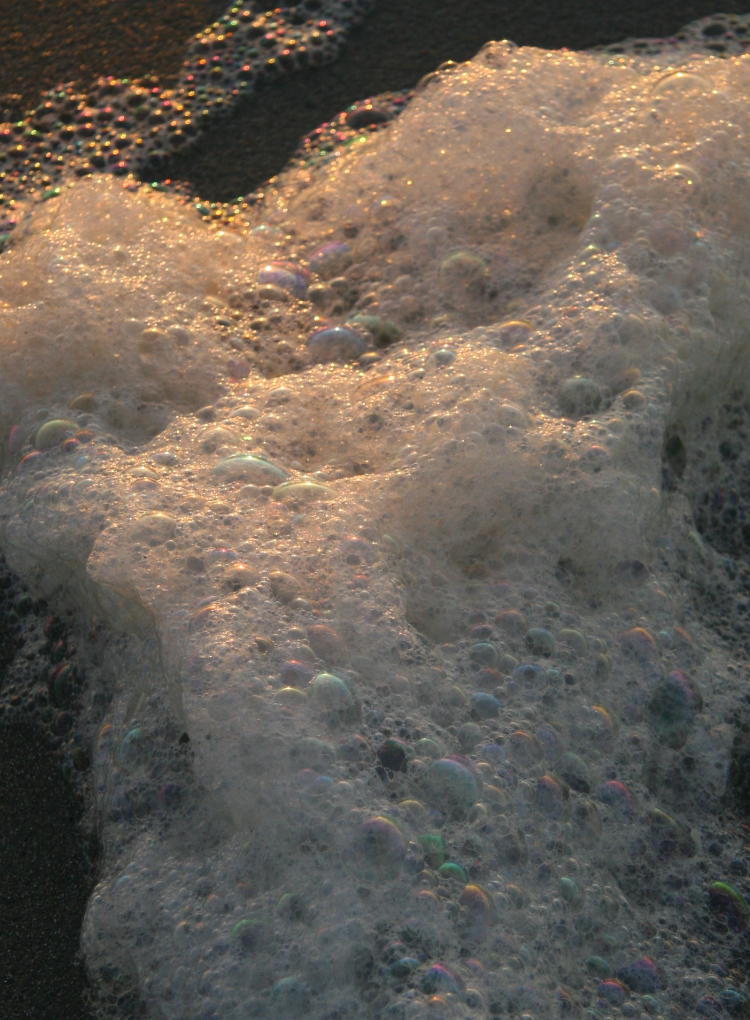
Not really as distinct as I would have liked, and I’ll have to pursue it a bit more, next beach trip. But then I turned my attention to the incoming mini-waves and how the early sunlight was interacting with them, trying for a little more abstract golden splashiness.

That’s… okay, but I’d still like better on this front too. This is a tighter crop, and the out-of-focus droplets at upper left get more distinct in a wider pic, but then the focused waves become less dominant. We’ll return to this someday.
In a couple of locations, the fiddler crabs were prominent, and at one point I actually attempted video of their territorial displays, but it didn’t really pan out. They’re very spooky, so drawing close enough for detailed video sent them diving into their burrows, and it took some time for them to come back out and start displaying again – this consists of waving their biggest pincer in the air like a newsboy selling papers in a depression-era movie. I tried waiting them out, sitting cross-legged on the ground at the edge of the marsh area, but I’d just drastically pulled a muscle in my side, by running into the sideview mirror on the car while putting the kayaks back on top, and I was too uncomfortable to wait them out. So we’ll settle for another view, two days later in Huntington Beach State Park.
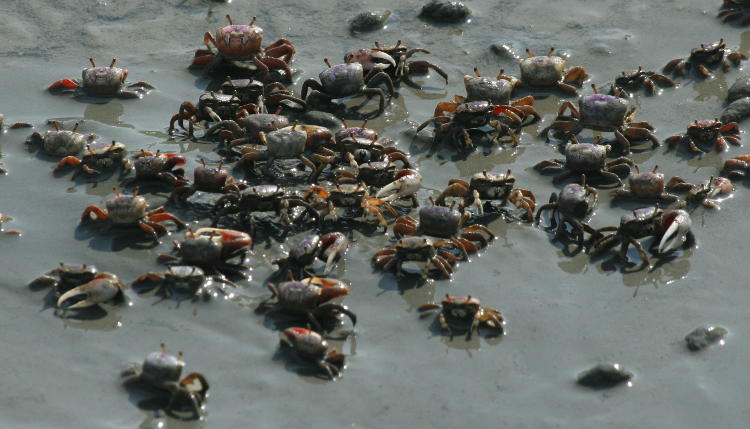
I’m only going to say that these are genus Uca, because I don’t have enough details to positively identify them and it’s pretty hard anyway. These flats were tidal, with some significant water level changes during the day, so this activity was very likely short-lived while the water was low – we weren’t there long enough to witness the full tidal shift. But, there were just a couple of them out there at that time.
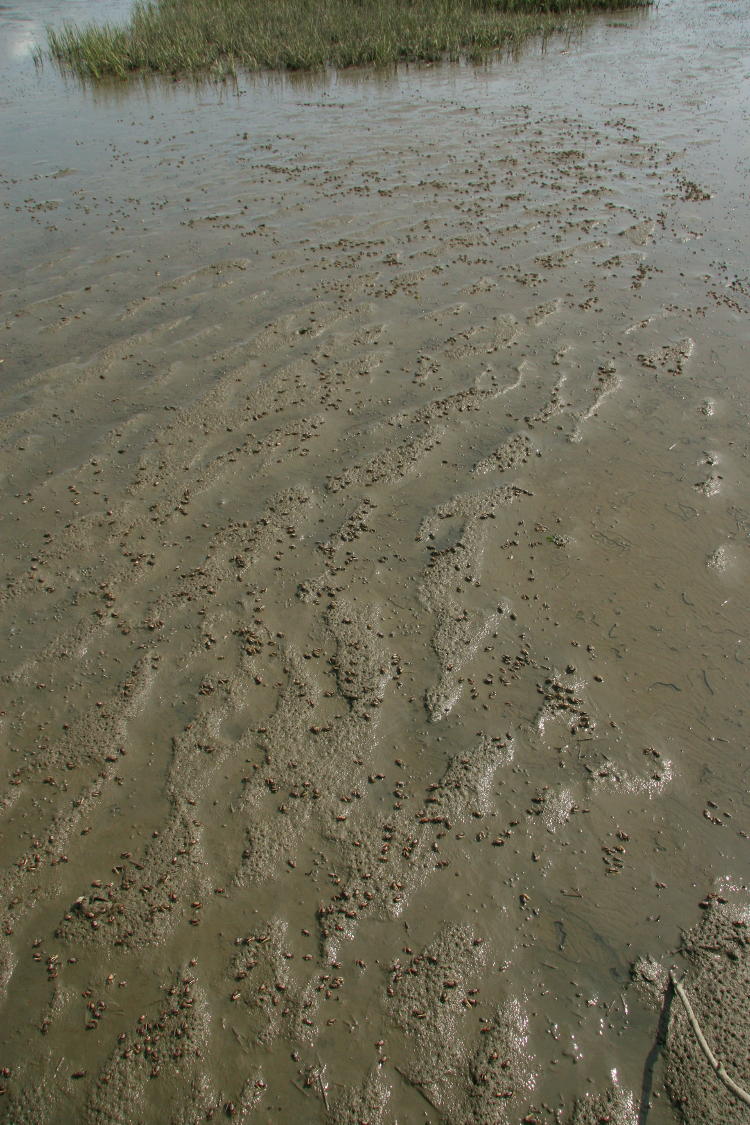
Yes, every one of those little ‘pebbles’ is a crab, and in places, they were marching along ridges of higher ground in a mass migration towards the good mud. There were so many that it was hard to imagine enough food to sustain them, but they seemed to be doing quite well. I’ve never seen an emaciated crab, to be honest.
A little further off, there was other activity.
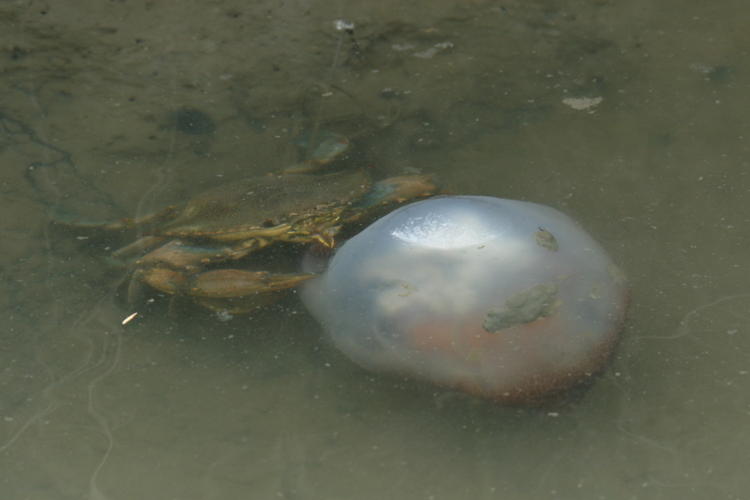
Where the flats gave way to channels, we saw a blue crab (Callinectes sapidus) nibbling, or so we thought, on one of the many jellyfish that dotted the area – they all seemed to be the same species, but I’m not making the effort to look it up right now. We started photographing several birds in the immediate vicinity, and looked back down again to find that it was two crabs, likely mating, and merely clasping the jelly negligently in one pincer; as they scuttled slowly along, they dragged the jelly with them. I got the impression this was the male’s offering to the female to convince her to, you know, dance, but I have no idea if this is how blue crabs work. They don’t, after all, have that huge pincer to wave around flamboyantly like the fiddlers do, so perhaps this is compensation. You really shouldn’t come to me for nature education…
Now, as we casually leave that subject matter behind, a little backstory. Mr Bugg has a tendency to refer to a particular tree, in a local hiking area, as my tree (and a few others as his own,) simply because I shot it twice in different conditions. I continually correct him that I don’t lay any claim to trees, or indeed any other subject – I just shoot what works for me.
Until now. This is MY tree.
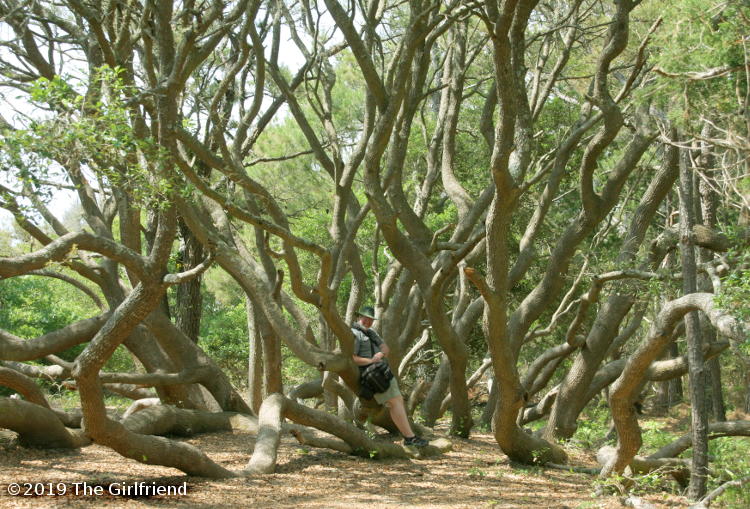
Hiking a little forest trail along a brackish pool in the same park, I spotted this as we approached and announced that I was going to find a way to take this home. I’m as positive as I can be (see the above bits about nature education) that this is all one tree, multiple trunks springing from the ground together and twisting around in a fantastic manner. I don’t know what it is, and welcome anyone’s identification of it, but what a marvelous tree it is, practically a grove by itself, and we shot numerous compositions of it. Buggato has said that he’s going to find it and photograph it himself, because he’s motivated by that kind of thing, and I wish him the best of luck in that endeavor.
One of the things that I had on my list for this trip was photographing, or at least seeing, a cottonmouth (Agkistrodon piscivorus,) often called a water moccasin, one of the venomous snakes in such areas – I’ve never seen one in the wild yet, despite many attempts. And so in this same region I was attempting yet again. Not far from the above tree was a very narrow path, almost overgrown by weeds and water reeds, that led to the edge of the brackish pond, and I very gingerly followed this, watching my footing intently because the location was ideal for such but the visibility pretty bad. I saw no signs of any snakes, but as I reached the edge of the water, something only a few meters to my left hit the water with a hell of a splash. In a minute, my suspicion was confirmed, as the alligator that I’d spooked while it was basking resurfaced and watched me warily.
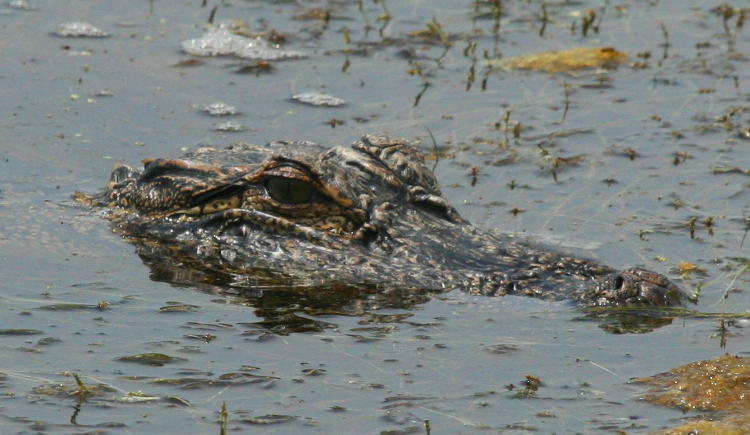
As American alligators (Alligator mississippiensis) go, this was a moderately small specimen, perhaps a little smaller than the one we’d seen previously, so not a threat to anything larger than a muskrat despite its ominous appearance; the exposed area of the head measured maybe 25cm, less than the length of my foot. But doesn’t it have the best damn shaping and texture? Alligators, along with sea turtles, are species that sculptors tend to minimize or stylize rather than depict accurately, and it’s a shame, because it’s the details that provide all of the personality, as far as I’m concerned.The Girlfriend keeps encouraging me to get more into sculpting (it’s extremely minimal right now,) and I might have to, just to produce proper renditions of such species.
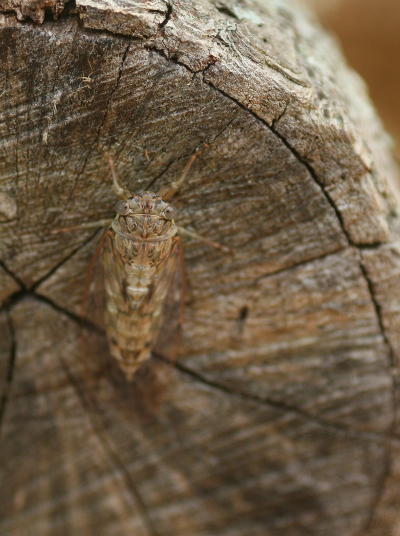 Now, despite taking advantage of an entirely different environment and class of subjects, I did not completely neglect my normal pursuits. On a cut-off stump not far from the previous two subjects here, The Girlfriend spotted what she initially took to be a moth, wonderfully camouflaged against the dry wood. But a closer look said otherwise.
Now, despite taking advantage of an entirely different environment and class of subjects, I did not completely neglect my normal pursuits. On a cut-off stump not far from the previous two subjects here, The Girlfriend spotted what she initially took to be a moth, wonderfully camouflaged against the dry wood. But a closer look said otherwise.
This was easily the smallest cicada species that I’d ever seen, and almost perfectly camouflaged in color and texture. I made a quick attempt to identify it through BugGuide.net, but didn’t initially find it and am not going to take the time for an idle pursuit – maybe later on when I’m cataloging. We’re heading down the page to a more detailed, profile shot as I type, while I mention that I did not come loaded for macro work, so the flash and softbox attachment were still sitting back in our room – this meant working with natural light under a forest canopy, so it’s actually a good amount of luck to have what I do. For the most part, this was a fairly lucky trip, really, with a couple of exceptions that I’ll be getting to in the upcoming bird post. And of course, I never did see any cottonmouth. Nor scorpions, though I admit I barely tried at all for this one, but one of these trips I’m going to rip the place up until I find and photograph one. I won’t admit to doing so until I’m successful, though – that’s a nature photography blogger’s tip.
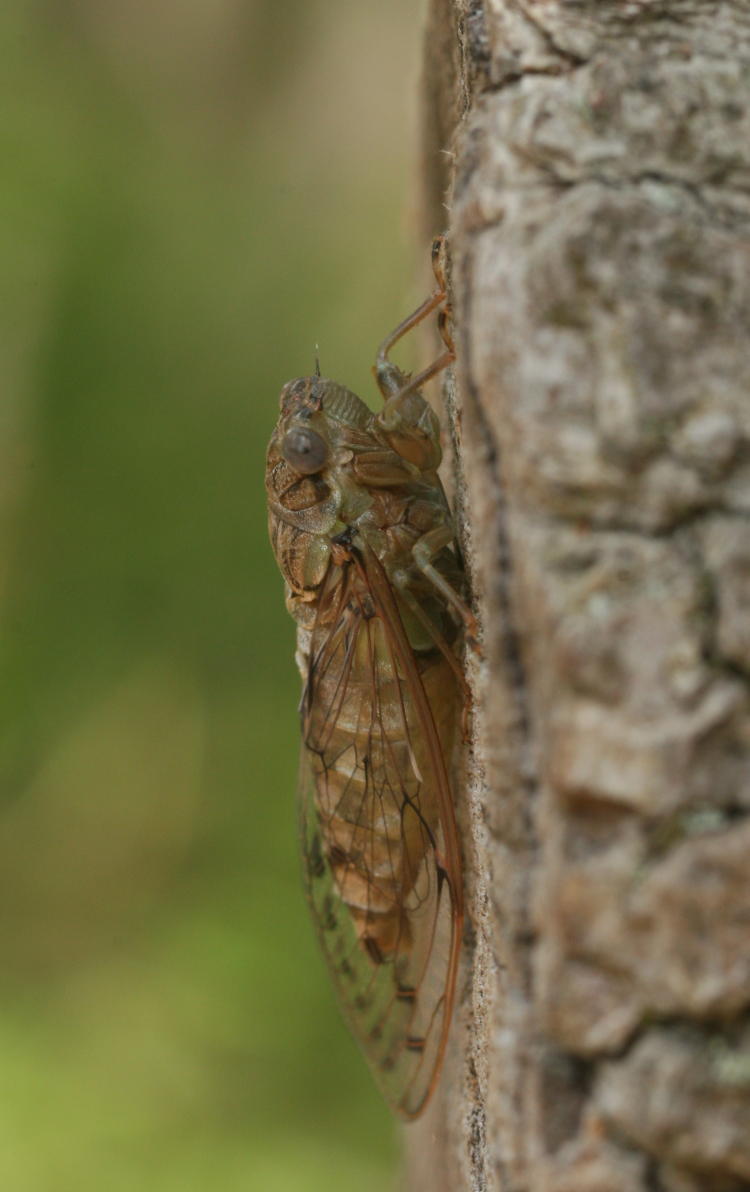
I’m getting in the habit of doing the ‘strong close,’ or what I like to imagine is one, anyway, so we’ll return to the beach and sunrise, to feature a tighter crop of a telephoto shot, taken while waiting for the sun to come up after spotting a distant fishing boat. The sky was nicely textured, so I included a significant portion against a very small boat, and the end effect (to me at least) is one of the sky practically looming over the boat, as if they would look behind them and see this huge red wall instead of, you know, the same kind of sky that I was seeing without the lens.
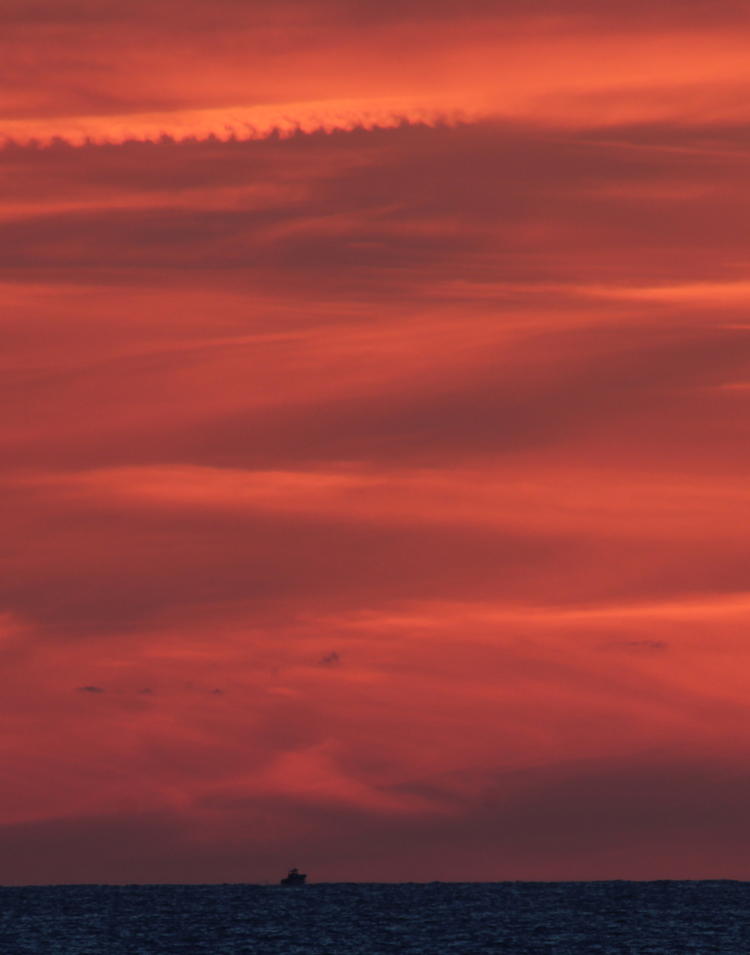
All the birds from this trip (well, not all of them) are on the way. Gonna be a big post.




















































